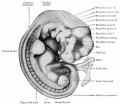File:Bailey087.jpg: Difference between revisions
No edit summary |
|||
| (4 intermediate revisions by 2 users not shown) | |||
| Line 1: | Line 1: | ||
==Fig. 87. Human embryo with twenty-seven primitive segments (7 mm | ==Fig. 87. Human embryo with twenty-seven primitive segments (7 mm, 26 days)== | ||
Mall. | Mall. | ||
In a 7 mm embryo described by Mall (Fig. 87), the flexures are slightly more accentuated than in the 4-mm stage. The branchial arches and grooves are still prominent. The first groove, of which the dorsal part marks the site of the external auditory meatus, is at this time particularly well developed. The eye is a stronger feature than in the preceding stage. The distinct depression in front of the first arch is the nasal fossa. The limb buds are larger than in the 4 mm embryo. The general curvature of the embryo is so sharp at this stage that the rudimentary tail is almost in contact with the head. | |||
Online editor - The term "branchial arch" in human embryos is now more commonly called a "pharyngeal arch". | |||
:'''Links:''' [[Book_-_Text-Book_of_Embryology_8#Fig087|Fig. 87 in text]] | [[Carnegie stage 14]] | [[Week 5]] | |||
{{Template:Bailey 1921 Figures}} | {{Template:Bailey 1921 Figures}} | ||
[[Category:Human]] [[Category:Franklin Mall]] [[Category:Carnegie Stage 13]] | [[Category:Human]] [[Category:Franklin Mall]] [[Category:Carnegie Stage 13]] [[Category:Carnegie Stage 14]] | ||
Latest revision as of 12:18, 29 January 2017
Fig. 87. Human embryo with twenty-seven primitive segments (7 mm, 26 days)
Mall.
In a 7 mm embryo described by Mall (Fig. 87), the flexures are slightly more accentuated than in the 4-mm stage. The branchial arches and grooves are still prominent. The first groove, of which the dorsal part marks the site of the external auditory meatus, is at this time particularly well developed. The eye is a stronger feature than in the preceding stage. The distinct depression in front of the first arch is the nasal fossa. The limb buds are larger than in the 4 mm embryo. The general curvature of the embryo is so sharp at this stage that the rudimentary tail is almost in contact with the head.
Online editor - The term "branchial arch" in human embryos is now more commonly called a "pharyngeal arch".
- Links: Fig. 87 in text | Carnegie stage 14 | Week 5
- Text-Book of Embryology: Germ cells | Maturation | Fertilization | Amphioxus | Frog | Chick | Mammalian | External body form | Connective tissues and skeletal | Vascular | Muscular | Alimentary tube and organs | Respiratory | Coelom, Diaphragm and Mesenteries | Urogenital | Integumentary | Nervous System | Special Sense | Foetal Membranes | Teratogenesis | Gallery of All Figures
| Historic Disclaimer - information about historic embryology pages |
|---|
| Pages where the terms "Historic" (textbooks, papers, people, recommendations) appear on this site, and sections within pages where this disclaimer appears, indicate that the content and scientific understanding are specific to the time of publication. This means that while some scientific descriptions are still accurate, the terminology and interpretation of the developmental mechanisms reflect the understanding at the time of original publication and those of the preceding periods, these terms, interpretations and recommendations may not reflect our current scientific understanding. (More? Embryology History | Historic Embryology Papers) |
Reference
Bailey FR. and Miller AM. Text-Book of Embryology (1921) New York: William Wood and Co.
Cite this page: Hill, M.A. (2024, April 16) Embryology Bailey087.jpg. Retrieved from https://embryology.med.unsw.edu.au/embryology/index.php/File:Bailey087.jpg
- © Dr Mark Hill 2024, UNSW Embryology ISBN: 978 0 7334 2609 4 - UNSW CRICOS Provider Code No. 00098G
File history
Click on a date/time to view the file as it appeared at that time.
| Date/Time | Thumbnail | Dimensions | User | Comment | |
|---|---|---|---|---|---|
| current | 15:45, 18 January 2011 |  | 928 × 803 (132 KB) | S8600021 (talk | contribs) |
You cannot overwrite this file.
